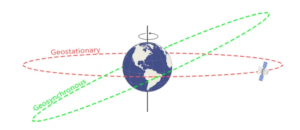Geostationary and Geosynchronous Satellite
A Geostationary Satellite is a type of Satellite kept in the Geostationary orbit (Circular in shape) and matches the rotational speed of the Earth. Whereas, a geosynchronous satellite revolves around the Earth in elliptical orbit and completes the one revolution in 24 hours.
Geostationary Satellite

Location and Coverage of Geostationary Satellite
Geostationary orbits are always inclined along the Equator.
Do you know why the TV signal receiving Antennas in India face south direction?
Because, India is located in the Northern Hemisphere and the Geosynchronous Satellites are located above the equator, In order to receive the signal from the satellite it is oriented south ward.
It covers about 40 percent of the Earth Surface. Three numbers of this Satellite separated by an angle of 120 Degrees covers the entire Earth.

Application of Geostationary Satellite
- To forecast the Weather: In order to assess and forecast the weather the weather data of a particular region needs to be monitored continuously. So, the satellite must focus on the the area for a longer duration of time therefore, Geostationary Satellite is used for weather forecast.
- To facilitate TV Communication: The TV Antenna mounted on the roof of our houses receives continuous signal from the Satellite. In order to receive the signal continuously, we set the orientation of our TV Antenna towards the satellite in the sky and we enjoy our TV shows. This is made possible by the Geostationary Satellite.
Limitation of Geostationary Satellite
- Limited Seats: The required location and chances of mutual interference of Signals, makes the number of Satellites limited.
- Late Comer: The Geostationary Satellites are kept in the High Earth Orbit. So, there is a time delay of 240 milliseconds in the round trip of signal.
- Slight Change in Position: The Position of the Geosynchronous Satellite changes slightly over because of the mutual interaction of Satellite and other celestial bodies in Solar System.
Geosynchronous Satellite
A geosynchronous Satellite revolves around the Earth in Geosynchronous orbit, is a high Earth orbit that allows satellites to match Earth’s rotation.
As this satellite orbits at the same speed that the Earth is spinning, the satellite appears on the same location to stay in place over a single point on the Earth surface.
Location of Geosynchronous Satellite
The position of this satellite is not fixed with respect to an observer on earth surface.
What do you think, will this satellite appear to stay stationary from any specific point?
Say, I start observing a this satellite from my home at Bhopal. Will it remain at the same location round the clock?
The answer is, NO, it will not.
Geostationary and Geosynchronous satellite – Comparison
| Parameter | Geostationary Satellite | Geosynchronous Satellite |
| Height From Earth Surface | 35,786 Km | 35,786 Km |
| Appearance in Sky from Earth | Always Static from any point on Earth | Highly Punctual, Appears on the Same location every day at a specific time but appears moving in the sky. |
| Inclination with respect to Equator Plane | Zero | Non Zero |
| Application | TV Communication | Weather, Communications and Surveillance. |
| Launch Vehicle used for launching | GSLV | PSLV |
Lets has a look on PSLV (Polar Satellite Launch Vehicle) and GSLV (Geosynchronous Satellite Launch Vehicle).
Geosynchronous Satellite Launched by PSLV
The Polar Satellite Launch Vehicle (PSLV) is a medium range launch vehicle designed and operated by the Indian Space Research Organisation (ISRO). It was developed to allow India to launch its Indian Remote Sensing Satellites into sun synchronous orbits.
India’s first lunar probe Chandrayaan-1, India’s first interplanetary mission was launched using PSLV. Mars Orbiter Mission (Mangalyaan) was also launched using PSLV.
One of the most successful mission using PSLV the launch of PSLV-C37 on 15 February 2017, successfully deploying 104 satellites into sun-synchronous orbit. It has both solid stage and liquid stages.
Geostationary Satellite Launched by GSLV (Geosynchronous Satellite Launch Vehicle)
The GSLV is a three stage/engine rocket. The core of first stage is fired with solid fuel, the second stage is the liquid fuel-propelled and the third is the cryogenic engine.
GSLV Mk III is a three-stage heavy lift launch vehicle developed by ISRO. GSLV Mk III is designed to carry 4-ton class of satellites into Geosynchronous Transfer Orbit (GTO) or about 10 tons to Low Earth Orbit (LEO), which is about twice the capability of GSLV Mk II.